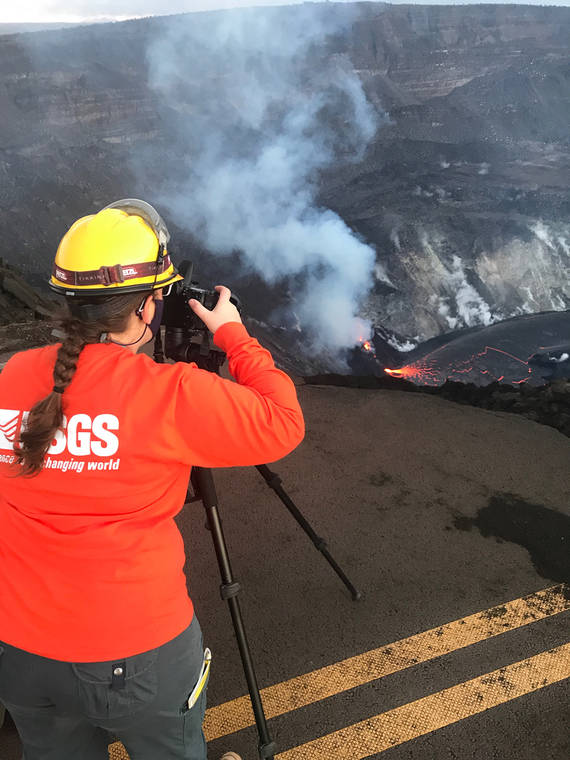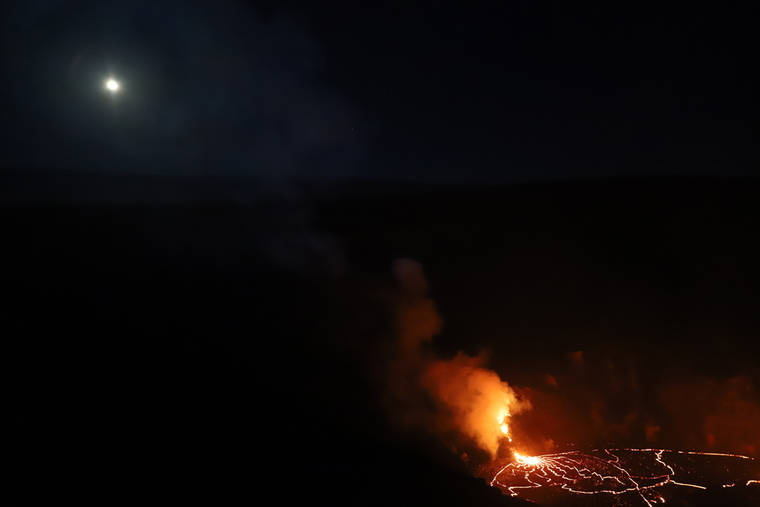Voggy conditions forecast for West Hawaii

The current eruption is confined to Halemaʻumaʻu crater within Hawai'i Volcanoes National Park but data from tiltmeters and Global Positioning System (GPS) stations show contraction in the upper portion of the East Rift Zone (an area between Kīlauea’s summit and Pu‘u ‘Ō‘ō). Similar instruments in down-rift areas, including the site of the 2018 eruption, are stable and do not show motion associated with either inflation or contraction. Recently, instruments at the summit have shown motions consistent with slight inflation. HVO interprets this as indicating that magma from the contracting portion of the East Rift Zone is flowing back to the summit reservoirs, where the eruption is occurring. The patterns of deformation could also be influenced by the decrease in the amount of lava erupted from the western fissure, and the draining of lava into the now submerged northern fissure vent. The signal is small and preliminary modeling shows it to be a small amount of magma returning to the summit. While magma from the summit reservoirs drained into the East Rift Zone to feed fissure eruptions in the lower East Rift Zone in 2018, there is no seismic or deformation data to indicate any changes have occurred in Kīlauea volcano’s lower East Rift Zone. No new hazards are expected as a result of this activity. This photo, taken on December 22, 2020, shows an HVO geophysicist installing a new Global Positioning System (GPS) station on the portion of Kīlauea's caldera that down-dropped during the 2018 summit collapse. The summit eruption plume is visible in the background. USGS photo by K. Kamibayashi.

HVO scientists monitor the ongoing Kīlauea summit eruption from within an area of Hawai‘i Volcanoes National Park that remains closed to the public for safety reasons. They are equipped with a range of specialized safety gear and personal protective equipment such as gas masks, helmets, gloves, and eye protection. No major changes were observed at the eruption site overnight and this morning: the west vent remains active and continues to feed the lava lake. USGS photo by L. DeSmither.

This photo, taken at approximately 5:30 a.m. December 29, 2020, shows Kīlauea's ongoing summit eruption. The western vent in the wall of Halema‘uma‘u continued to erupt overnight, and the northern/eastern vent remained inactive. At approximately 3:45 a.m. HST today (Dec. 29), HVO field crews measured the lava lake as 179 m (587 ft) deep. USGS photo by H. Dietterich.
Vog is expected to return to West Hawaii areas as northeasterly tradewinds take hold following several days of relatively clear skies.
Vog is expected to return to West Hawaii areas as northeasterly tradewinds take hold following several days of relatively clear skies.
With the tradewinds forecast to continue through at least Friday, portions of Hawaii Island, primarily the North Kona, South Kona and Ka‘u districts, may experience “intermittent concentrations” of vog from Kilauea Volcano’s ongoing summit eruption, forecasters with the University of Hawaii at Manoa’s Vog Measurement and Prediction Project said Tuesday afternoon.
Air quality could decrease to “moderate,” which is considered acceptable, however, there may be health concerns for a small number of people. The remainder of the state will experience no vog impacts, according to the project.
Though the winds are forecast to bring the vog, or volcanic smog, across West Hawaii, the amount of sulfur dioxide and other gases, which make up vog, being emitted from Kilauea Volcano continues to decrease.
The Hawaiian Volcano Observatory said Tuesday morning the volcano was pumping out 3,300 tons per day of sulfur dioxide (SO2) as of Monday afternoon. That’s down from 5,500 tons per day on Sunday, and a drastic reduction from the start of the eruption when an estimated 35,000 to 40,000 tons of SO2 was being released from Halema‘uma‘u crater.
The observatory said 3,300 to 5,500 tons per day were in the range of emission rates common for the lava lake that developed inside Halema‘uma‘u prior to the 2018 lower East Rift Zone eruption.
Meanwhile, lava activity remains confined to Halemaʻumaʻu on the northwest side of the crater. As of 4 a.m. Tuesday, the lava lake was estimated at 587 feet to 591 feet deep with a narrow black ledge around it, according to the observatory.
The lake’s volume was about 5 billion gallons and it covered about 72 acres. It remained was about 1,340 feet below the rim of Halema‘uma‘u.
For more information on the ongoing eruption, visit https://www.usgs.gov/observatories/hawaiian-volcano-observatory. For more information on vog, including ways to monitor air quality, visit https://vog.ivhhn.org.


